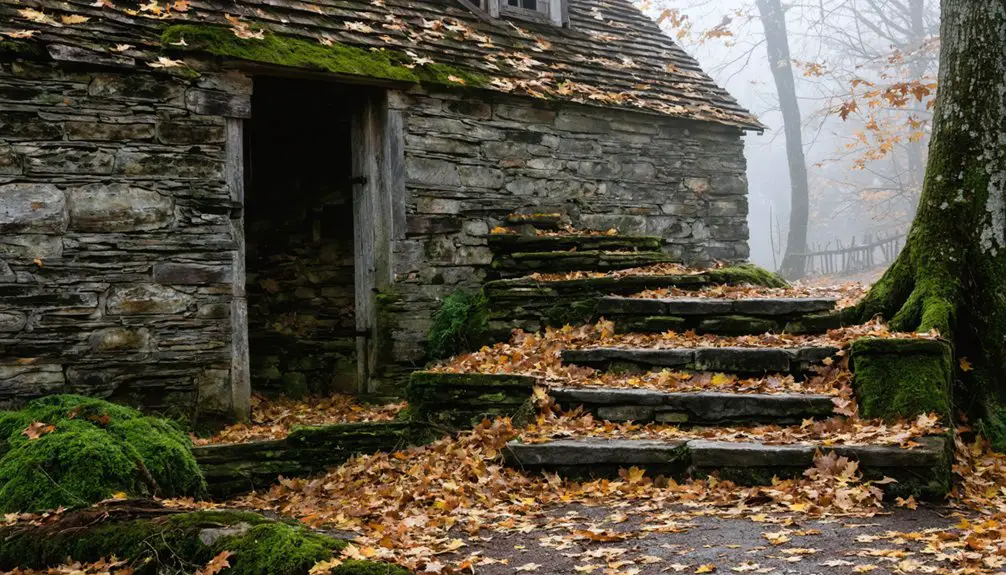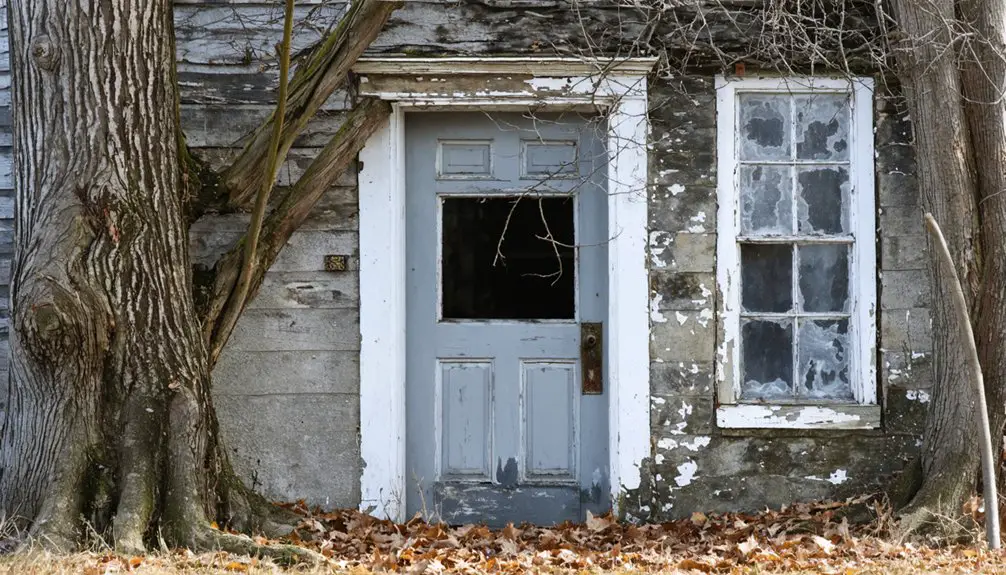You’ll find North Sherburne’s ghostly remains nestled in Vermont’s hills, where Isaiah Washburn first settled in 1785. This once-thriving lumber town flourished around the historic Dutton House, built in 1781, which still stands as a symbol of colonial life. Today, you can explore stone foundations, cellar holes, and abandoned carriage roads while locals whisper tales of mysterious footsteps and unexplained laughter echoing from the town’s historic structures.
Key Takeaways
- North Sherburne was a prosperous mill and logging community in Vermont that declined into a ghost town after economic changes.
- Physical remnants include stone foundations and cellar holes, marking the locations of former buildings and homes.
- The community’s strategic location enabled profitable timber exports to Quebec via river routes during its peak.
- Local legends feature mysterious apparitions along old carriage roads, contributing to the town’s ghostly reputation.
- The town’s history is preserved through museum exhibits, digital archives, and archaeological findings from the abandoned settlement.
The Birth of a Vermont Settlement
When New Hampshire Governor Benning Wentworth chartered the town of Shelburne on August 18, 1763, he set in motion the establishment of what would become North Sherburne.
Though initially planned for 23,500 acres, surveying errors reduced the actual land distribution. You’ll find the area’s first true settler experiences began with John Potter at Shelburne Point in 1768, where he launched the region’s lumber trade. The town’s name caused some navigation confusion since it shared multiple Shelburne references.
The settlement, originally known as Killington, didn’t see substantial growth until after the Revolutionary War. Isaiah Washburn and Nathaniel Fuller arrived in 1785, marking the start of organized land occupancy. Noted surveyor Ira Allen mapped out the original town layout.
Early Life and Growing Community
North Sherburne’s early settlers blazed their way from the Woodstock area in 1785, following primitive trails near the Bridgewater line to establish their new homes.
You’d have found these pioneering families, like Isaiah Washburn with his 50 acres, building their lives along the Queechy River where two dozen houses soon lined River Road.
Settler lifestyles centered around self-sufficiency, with families clearing land for subsistence farming and relying on community resources.
Early settlers lived off their own labor, working cleared fields and sharing local resources to sustain their growing community.
Agricultural practices included raising livestock, growing grains, and producing wool.
Early settlers faced challenges accessing services, having to travel through stiff clay to sandy soil types while transporting goods.
You’d have seen the landscape transform as mills emerged – first Ira Allen’s sawmill and forge, then gristmills and wool processing operations.
The community’s lifeblood flowed through shared resources and growing trade networks, connected by new turnpikes and stagecoach roads to surrounding towns like Rutland and Burlington.
Similar to John Potter who became first known resident of Shelburne in 1768, these early settlers were instrumental in establishing the foundations of their community.
Historic Landmarks and Architecture

Standing as a tribute to Vermont’s colonial heritage, the Dutton House anchors North Sherburne’s architectural legacy with its distinctive saltbox style and sprawling 45-acre grounds.
You’ll find diverse architectural styles throughout the area, from the iconic covered bridge near Dutton House to traditional timber-frame farmhouses with their characteristic clapboard siding and central chimneys. The home’s original construction in 1781 by Salmon Dutton established an enduring architectural presence in the region.
While preservation efforts have maintained the Dutton House as part of the Shelburne Museum, many other historic structures tell a different story. Mill ruins and abandoned farmhouses, resting on typical New England stone foundations, have succumbed to time’s passage. Reports of spirits in the Dutton House have persisted since employees witnessed mysterious figures in the attic.
The area’s vernacular architecture reflects 19th-century rural practicality, with utilitarian outbuildings and simple post-and-beam construction techniques showcasing the resourcefulness of early settlers.
Economic Rise and Fall
You’ll find North Sherburne’s economic foundation started in 1785 when Isaiah Washburn claimed 50 acres, establishing a pattern of settlement that quickly expanded through agriculture and timber operations.
The town’s strategic location near Lake Champlain enabled profitable timber exports to Quebec markets, while local families like the Easterbrooks and Fullers contributed to the growing workforce and economic development. Many abandoned buildings remain, providing glimpses into the town’s prosperous past.
The area’s population grew to include sixty-two plus Vermonters who established homes and farms throughout the village.
Early Industry and Commerce
While many early American settlements relied on agriculture for sustenance, North Sherburne’s economic foundation emerged from its thriving timber industry in the late 1700s.
You’ll find that daring settlers transported valuable oak timber via river rafts to Quebec’s lucrative markets, though they faced significant dangers requiring armed escorts through hostile territories.
The region’s economic viability depended on several key factors:
- Extensive timber resources that attracted early settlers like Isaiah Washburn
- Strategic river routes enabling profitable timber transport to Canadian markets
- Lottery-funded road systems connecting to major towns like Rutland
- Established postal services facilitating essential trade communications
This robust commerce helped transform North Sherburne from a frontier outpost into a bustling trade hub, with locations like Bloody Island and Bloody Point serving as stark reminders of the risks early traders endured.
Population’s Economic Impact
The economic importance of North Sherburne closely mirrored its population fluctuations throughout the town’s history.
You’ll find that with just 62 residents in the early 1800s, limited agricultural land restricted economic diversification. Population trends show growth to 1,300 by 1890, but numbers fell to 997 by 1920 as farming limitations and commercial stagnation took hold.
You can trace the town’s financial decline through its post office, which opened and closed multiple times during the 19th century.
However, post-WWII suburban expansion near Burlington brought new life to the region, with population surging beyond 6,900 by century’s end. This growth transformed North Sherburne’s economic base from purely agricultural to a mixed suburban economy, though the original settlement ultimately became a ghost town.
Tales From the Dutton House

You’ll find the Dutton House, built in 1781 by Justice of the Peace Salmon Dutton, stands as one of North Sherburne’s most historically significant structures with its salt-box design and multiple business uses spanning tavern, inn, and store operations.
The house’s documented deaths and reported paranormal activity, investigated by the Green Mountain Paranormal Society, have made it a focal point for ghost hunters and Halloween tours at its current Shelburne Museum location.
When Redfield Proctor Jr. saved the building from demolition in 1950, he preserved not just the architectural features and stenciled walls, but also the rich stories of early Vermont entrepreneurship that continue to captivate visitors today. The early American decorative arts are particularly evident in the distinctive stencil paintings that adorn the interior walls from around 1800. The structure features an asymmetrical roof line characteristic of traditional New England saltbox architecture.
Original Family Occupants
In 1781, prominent Massachusetts native Salmon Dutton established what would become a remarkable family legacy when he built the Dutton House in Cavendish, Vermont.
As a demonstration of his community engagement, Dutton served multiple civic roles including road surveyor, justice of the peace, and town treasurer.
The Dutton family’s entrepreneurial spirit transformed their home into a thriving hub of activity, featuring:
- A store serving local residents
- A tavern welcoming weary travelers
- An inn providing comfortable lodging
- A boarding house supporting mill workers
You’ll find it fascinating that this versatile dwelling housed multiple generations of Duttons until the early 1900s, with the family adding various expansions to accommodate their growing needs.
Their century-long occupancy deeply influenced Vermont’s early development and settlement patterns.
Paranormal Activity Reports
Since relocating to the Shelburne Museum in 1950, the Dutton House has garnered significant attention for its reported paranormal activity.
You’ll find consistent reports of ghostly encounters from staff and visitors alike, including unexplained child laughter, mysterious footsteps on empty floors, and rocking cradles moved by unseen forces.
Three distinct spirits reportedly inhabit the house: a welcoming female figure, a homesick child, and a resentful older male – all believed to be former Dutton family members.
Spirit communication manifests through direct messages like “Come see our home!” while paranormal investigators have documented unexplained sounds and movements.
The building’s rich history, with over 11 reported deaths by the 1900s and its varied use as a home, store, and tavern, provides context for these supernatural claims.
While some visitors experience vivid paranormal events, others detect nothing unusual.
Historical Building Significance
The Dutton House stands as a remarkable tribute to early American ingenuity and adaptation. Built in 1781 by Salmon Dutton, this architectural preservation marvel showcases Vermont’s rich cultural heritage through its evolution from a simple saltbox cottage to a dynamic community hub.
You’ll find four distinctive features that make this structure historically significant:
- Original stencil artwork adorning the walls, including patriotic eagles and grape leaf borders
- Adaptable design that served as home, tavern, inn, and business office
- Exemplary preservation of early American construction techniques
- Authentic representation of New England entrepreneurial spirit
When threatened by highway expansion in 1950, the building found new life at Shelburne Museum, where you can now explore its meticulously restored rooms and experience the innovative spirit of early Vermont settlers.
Legacy of a Vanished Town
Once a thriving mill and logging community nestled in Vermont’s hills, North Sherburne‘s legacy lives on through its haunting physical remains and rich folklore.
You’ll find its cultural significance preserved in stone foundations and cellar holes that dot the landscape, while local legends tell tales of mysterious apparitions along overgrown carriage roads.
The town’s historical preservation efforts combine archaeological findings with ghostly narratives, drawing both historians and paranormal enthusiasts to explore its abandoned remnants.
Today, North Sherburne serves as a powerful reminder of Vermont’s rural past, with its story kept alive through museum exhibits, digital archives, and educational programs.
Through these various channels, you’re able to glimpse how changing economic forces transformed this once-vibrant community into an enchanting ghost town.
Frequently Asked Questions
Are There Any Remaining Residents Living in North Sherburne Today?
You’ll find the current population figures are inconclusive since North Sherburne’s data merges with Shelburne’s 8,000+ residents. Despite local legends, there’s evidence of active households in the broader area.
What Happened to the Original Town Records After Its Decline?
You won’t find direct access to town archives today, as they’ve likely scattered or been lost during administrative changes. Some records survive in Vermont State Papers and regional historical preservation societies.
Can Visitors Legally Explore the Abandoned Structures in North Sherburne?
You can’t legally explore the abandoned structures without explicit permission, as private property laws and legal restrictions prohibit unauthorized access. Contact property owners first to avoid trespassing violations.
Were There Any Notable Native American Settlements Before European Colonization?
Like footprints in ancient soil, Native American tribes – primarily Western Abenaki and Sokoki – left traces near this area’s waterways, though you’ll find limited archaeological evidence of permanent pre-colonial settlements here.
What Natural Disasters or Events Contributed to North Sherburne’s Abandonment?
You’ll find repeated flooding incidents along river systems caused significant structural damage, while harsh winters and economic decline from industry changes gradually pushed residents to abandon their settlement over time.
References
- http://hauntedhouses.com/vermont/dutton-house/
- http://sites.rootsweb.com/~vermont/ChittendenShelburne.html
- https://www.instagram.com/reel/DBqvoTHO7Ck/
- https://preservationinpink.wordpress.com/abandoned-vermont/
- https://www.sherburnelibrary.org/wp-content/uploads/2022/04/An_Informal_History_of_the_Town_of_Sherburne_web.pdf
- https://en.wikipedia.org/wiki/Shelburne_Village_Historic_District
- https://en.wikipedia.org/wiki/Shelburne
- https://www.vermonter.com/shelburne-vermont-history/
- https://www.uvm.edu/~hp206/2010/Shelburne/history.html
- https://npgallery.nps.gov/GetAsset/c1b86f60-c949-4915-801b-c87b98bb6c45



